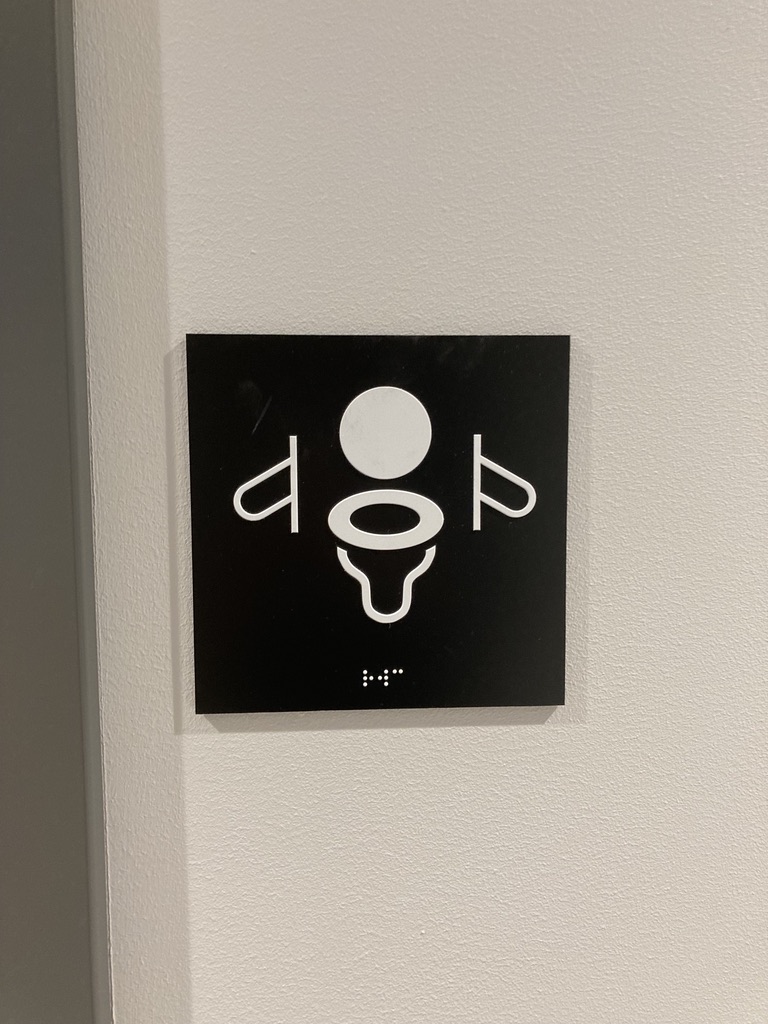For the last ten years, the concept of “categorisation” has become a critical key in our research.
Categorisation means sorting people into different categories, such as “persons with disabilities”, “men”, “women”, “normal”, etc. It creates divisions between groups, which isn’t unproblematic.
This critical perspective has unlocked a new strand of reasoning that I didn’t have sufficient access to before.
Categorisation is an Act
First of all, categorisation is an act. It is always done to someone by someone. Because of this, we work with “categorisation” rather than “category” to emphasise that it is an active process [1].
Secondly, acts of categorisation value certain perspectives and silence others, giving advantages to some and disadvantages to others. This is often being done in an invisible way [2].
In short, categorisation is not innocent. In Picture 1, someone has peeled off the wheel from the wheelchair sign. I wish I could ask the person who did it why.
Three Ways Categorisation Can Help Us
1. As a Key to Exploring Photos and Texts Together
We have used categorisation to explore collections and collages of research material, such as texts and photos, together. This can, for instance, open up for discussions of gender as a categorisational ground, and “Gendered Sustainability” [3].
2. As a Driver for Conceptual Development
Our discussions of categorisations have elicited a critique of the taken-for-granted-good term “Inclusion”. Categorisations in themselves are done by including and excluding someone or something, based on some criteria. This means that “to include” someone involves power [4].
3. As a Portal to Linguistic and Design Openings and Solutions
As Bowker and Starr say, “To classify is human” [2, p.1]. But do we need to categorise bodies, persons and roles as much as we do today, and what are the alternatives? One alternative that we are exploring is a shift in categoriational grounds, from inclusion to “nonclusion”[5], from person to function or situation [6].
Nonclusive Design – Beyond Bodies and Roles
Nonclusive design stands for a shift in categorisation:
“Nonclusive design means design that resists categorisations of bodies/roles and that does not come with predefined or presupposed limits in terms of who it is meant for.” [5]
One concrete example of nonclusion can be seen in Figure 2, where the people, babies and families that are often found on toilet doors have been replaced with a water closet with handrails.

The sign refrains from categorising "who" is meant/allowed to use the toilet. Instead, it describes the nature of the room and its features. This creates a shift in narrative from the individual towards the environment.
Rather than asking “who” the design is for, we propose asking “what functions, facilities or situations” it supports. This shift resists the impulse to categorise bodies and roles, and instead focuses on environments, interaction, and variation.
I will continue exploring how this shift affects design practices and research in upcoming posts.
This piece builds on findings from The Syntax of Equality project, where we investigate situation-based categorisation and nonclusive design through citizen science and field observations.
For a detailed academic exploration of these ideas, start here:
- Hornscheidt, A. (2009). Intersectional challenges to gender studies–gender studies as a challenge to intersectionality. Gender Delight. Science, Knowledge, Culture and Writing… for Nina Lykke. Linköping: LiU-Tryck, 33–46.
- Bowker, G. C., & Star, S. L. (1999). Sorting Things Out: Classification and Its Consequences. MIT Press.
- Sandström, I., Ericsson, S., & Hedvall, P.-O. (2024). Gendered sustainability: Are public spaces designed for girls good for everyone?: Examining female participation as a strategy for inclusive public space. Cities, 149, 104906. https://doi.org/10.1016/j.cities.2024.104906.
- Hedvall, P.-O., & Ericsson, S. (2024). The Problem with “Inclusion”? It Is Done to Someone by Someone. In Universal Design 2024: Shaping a Sustainable, Equitable and Resilient Future for All (pp. 18–25). IOS Press. https://doi.org/10.3233/SHTI240978.
- Hedvall, P.-O., Price, M., Keller, J., & Ericsson, S. (2022). Towards 3rd Generation Universal Design: Exploring Nonclusive Design. Transforming Our World through Universal Design for Human Development, 85–92. https://doi.org/10.3233/SHTI220824.
- Ericsson, S., & Hedvall, P. O. (2024). Situation, Non-categorisation, and Variation—Conveying Nonclusion Through Text and Image. In Difference – Sketching, Visualising and challenging Universal Design in Sweden (Vol. 19, pp. 31–50). Design for All Institute of India. http://designforall.in/?mdocs-file=2472.
Thanks for reading Dignity and Diversity by Design – with Per-Olof Hedvall! Subscribe for free to receive new posts. Thanks for your support 🫶

